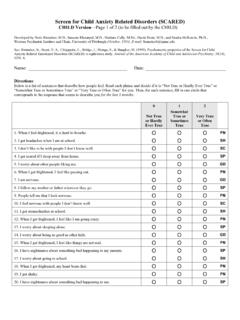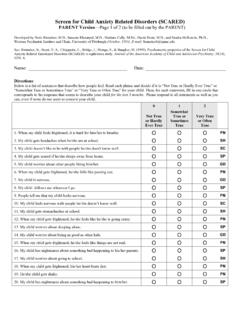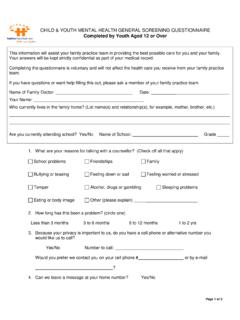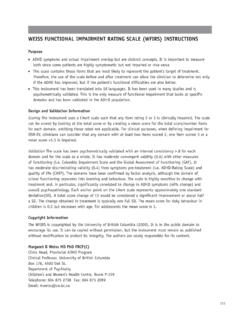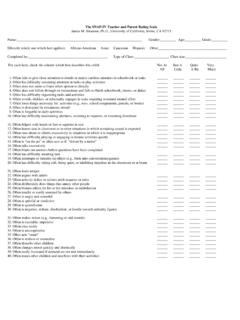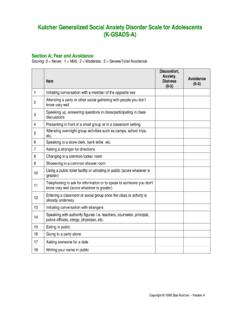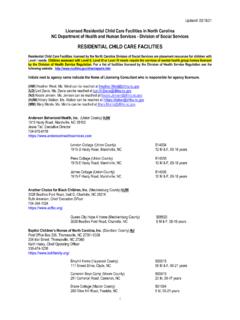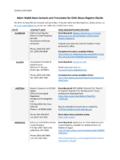Transcription of SNAP-IV 26-Item Teacher and Parent Rating Scale James M ...
1 SNAP-IV 26-Item Teacher and Parent Rating Scale James M. Swanson, , University of California, Irvine, CA 92715 Patient/Client Name: _____ Date of birth: _____ Gender: _____ Grade: _____ Type of class: _____ Class size: _____ Completed by: _____ Date: _____ Physician Name: _____ For each item, check the column which best describes this child /adolescent: Not at all Just a little Quite a bit Very much 1. Often fails to give close attention to details or makes careless mistakes in schoolwork or tasks 2. Often has difficulty sustaining attention in tasks or play activities 3. Often does not seem to listen when spoken to directly 4. Often does not follow through on instructions and fails to finish schoolwork, chores, or duties 5. Often has difficulty organizing tasks and activities 6. Often avoids, dislikes, or reluctantly engages in tasks requiring sustained mental effort 7. Often loses things necessary for activities ( , toys, school assignments, pencils or books 8.)
2 Often is distracted by extraneous stimuli 9. Often is forgetful in daily activities 10. Often fidgets with hands or feet or squirms in seat 11. Often leaves seat in classroom or in other situations in which remaining seated is expected 12. Often runs about or climbs excessively in situations in which it is inappropriate 13. Often has difficulty playing or engaging in leisure activities quietly 14. Often is on the go or often acts as if driven by a motor 15. Often talks excessively 16. Often blurts out answers before questions have been completed 17. Often has difficulty awaiting turn 18. Often interrupts or intrudes on others ( , butts into conversations/ games 19. Often loses temper 20. Often argues with adults 21. Often actively defies or refuses adult requests or rules 22. Often deliberately does things that annoy other people 23. Often blames others for his or her mistakes or misbehaviour 24. Often is touchy or easily annoyed by others 25.)
3 Often is angry and resentful 26. Often is spiteful or vindictive Scoring guide for SNAP-IV 26-Item Teacher and Parent Rating Scale The SNAP-IV 26-Item Scale is an abbreviated version of the Swanson, Nolan, and Pelham (SNAP) Questionnaire (Swanson, 1992; Swanson et al., 1983). Items from the DSM-IV criteria for attention-deficit/hyperactivity disorder (ADHD) are included for the two subsets of symptoms: Inattention (items 1 9) and Hyperactivity/Impulsivity (items 10 18). Also, items from the DSM-IV criteria for oppositional defiant disorder (ODD) are included (items 19 26) because ODD is often present in children with ADHD. Symptom severity is rated on a 4-point Scale . Responses are scored as follows: Not at all = 0 Just a little = 1 Quite a bit = 2 Very much = 3 The scores in each of the three subsets (inattention, hyperactivity/impulsivity, and opposition/defiance) are totalled. A suggested scoring guideline is below: Questions 1 9: Inattention Subset < 13/27 = Symptoms not clinically significant 13 17 = Mild symptoms 18 22 = Moderate symptoms 23 27 = Severe symptoms Questions 10 18: Hyperactivity/Impulsivity Subset <13/27 = Symptoms not clinically significant 13 17 = Mild symptoms 18 22 = Moderate symptoms 23 27 = Severe symptoms Questions 19 26: Opposition/Defiance Subset < 8/24 = Symptoms not clinically significant 8 13 = Mild symptoms 14 18 = Moderate symptoms 19 24 = Severe symptoms Suggested Targets: <13/27 for inattention <13/27 for hyperactivity/impulsivity <8/24 for oppositional defiant disorder If desired, the average Rating for each subset can be calculated by totalling the scores for the items in the subset and dividing by the number of items.
4 The average can be compared with cut-off scores suggestive of ADHD reported in the literature.
